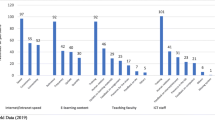Abstract
The time and spatial constraints of face-to-face learning often affect nursing staff’s inclination to enroll in ladder system training classes. Hence, their competence in clinical care may be unable to meet the requirements of the hospitals they work at. The e-learning mechanism offers a way to overcome such constraints. However, the differences in learners’ achievement and satisfaction between traditional face-to-face and non-synchronized e-learning classes in the nursing clinical ladder system have not been thoroughly investigated. In this study, 155 nursing personnel serving at the case hospital, enrolled in N1/N2 ladder courses, were invited to participate as the subjects. The results showed that those who attended face-to-face learning classes reported higher satisfaction but achieved less in class than those in the e-learning class. The factors which influence the subjects’ satisfaction with e-learning were investigated and summarized.

Similar content being viewed by others
Explore related subjects
Discover the latest articles and news from researchers in related subjects, suggested using machine learning.References
Western, P., QA/QI and nursing competence: A combined model. Nurs. Manage 25(3):44–46, 1994. doi:10.1097/00006247-199403000-00011.
Girot, E. A., Assessment of competence in clinical practice: a phenomenological approach. J. Adv. Nurs 18(1):114–119, 1993. doi:10.1046/j.1365-2648.1993.18010114.x.
Malik, D. M., Career ladders: position enrichment vis-a-vis tenure. Nurs. Manag. 22(10):120A, 1991. 120D, 120F.
Guerrero, J. H., and Hansen, M. L., Career ladder program. J. Contin. Educ. Nurs 24(1):32–36, 1993.
Kreider, M. C., and Barry, M., Clinical ladder development: implementing contract learning. J. Contin. Educ. Nurs 24(4):166–169, 1993.
Chen, C., Chang, R., Hung, M., Lin, M.: Assessing the quality of a web-based learning system for nurses. J. Med. Syst., 2008. doi:10.1007/s10916-008-9193-1
Parkinson, C. F., and Parkinson, S. B., A comparative study between interactive television and traditional lecture course offerings for nursing students. Nurs. Health Care 10(9):498–502, 1989.
Daly, J. M., McClelland, E., and Yang, J., The effect of teaching via telecommunications: a comparison of the academic performance of RN-BSN students in satellite centers and on campus. J. Nurs. Educ. 33(4):172–174, 1994.
Shomaker, D., and Fairbanks, J., Evaluation of an RN-to-BSN distance education program via satellite for nurses in rural health care. J. Nurs. Educ. 36(7):328–330, 1997.
Heetebry, I., Hatcher, M., and Tabriziani, H., Web based health education, e-learning, for weight management. J. Med. Syst. 29(6):611–617, 2005. doi:10.1007/s10916-005-6129-x.
Lau, F., and Bates, J., A review of e-learning practices for undergraduate medical education. J. Med. Syst. 28(1):71–87, 2004. doi:10.1023/B:JOMS.0000021522.30587.ff.
Reis, J., McGinty, B., and Jones, S., An e-learning caregiving program for prostate cancer patients and family Members. J. Med. Syst. 27(1):1–12, 2003. doi:10.1023/A:1021040911088.
Zimmer, M., Rational for a ladder for advancement in nursing practice. J. Nurs. Adm. 72(6):18–24, 1972. doi:10.1097/00005110-197211000-00008.
Benner, P., From novice to expert: excellence and power in clinical nursing practice. Addison-Wesley, Menlo Park, 1984.
Buchan, J., Evaluating the benefits of a clinical ladder for nursing staff: an international review. Int. J. Nurs. Stud. 36(2):137–144, 1999. doi:10.1016/S0020-7489(99)00005-X.
Pettno, P., A four-level clinical ladder. Nurs. Manage 29(7):52–53, 1998. doi:10.1097/00006247-199807000-00015.
Schmidt, L. A., Nelson, D., and Godfrey, L. P., A clinical ladder program based on Carper's fundamental patterns of knowing in nursing. J. Nurs. Adm. 33(3):146–152, 2003. doi:10.1097/00005110-200303000-00005.
Froman, R., Assessing the credibility of a clinical ladder review process: an interrater reliability study. Nurs. Outlook 49(1):27–29, 2001. doi:10.1067/mno.2001.110269.
Turner, P., Benefits and costs of continuing nursing education: an analytical survey. J. Contin. Educ. Nurs 22(3):104–108, 1991.
Brooks, E. L., Fletcher, K., and Wahlstedt, P. A., Focus group inter-views: assessment of continuing education needs for the advance practical nurse. J. Contin. Educ. Nurs 29(1):27–31, 1998.
Chapman, L., Distance learning for post-registered nursing: the facts. Nurs. Stand 14(18):33–36, 2000.
Yang, K., Yu, S., Lin, M., and Hsu, C., Study of basic computer competence among public health nurses in Taiwan. J. Nurs. Res. 12(1):1–9, 2004.
Hsiao Sheen, S.-T., Chang, W.-Y., Chen, H.-L., Chao, H.-L., and Tseng, C. P., E-learning education program for registered nurses: the experience of a teaching medical center. J. Nurs. Res. 16(3):195–201, 2008.
Sun, P.-C., Tsai, R. J., Finger, G., Chen, Y.-Y., and Dowming, Y., What drives a successful e-Learning? An empirical investigation of the critical factors influencing learner satisfaction. Comput. Educ. 50(4):1183–1202, 2008. doi:10.1016/j.compedu.2006.11.007.
Acknowledgements
This research was supported by the Chia Nan University of Pharmacy and Science.
Author information
Authors and Affiliations
Corresponding author
Appendices
Appendix 1
Appendix 2
Rights and permissions
About this article
Cite this article
Leu, LJ., Liao, HC., Chang, IC. et al. Applying Non-synchronized E-learning to the Nursing Clinical Ladder System. J Med Syst 34, 909–917 (2010). https://doi.org/10.1007/s10916-009-9306-5
Received:
Accepted:
Published:
Issue Date:
DOI: https://doi.org/10.1007/s10916-009-9306-5




